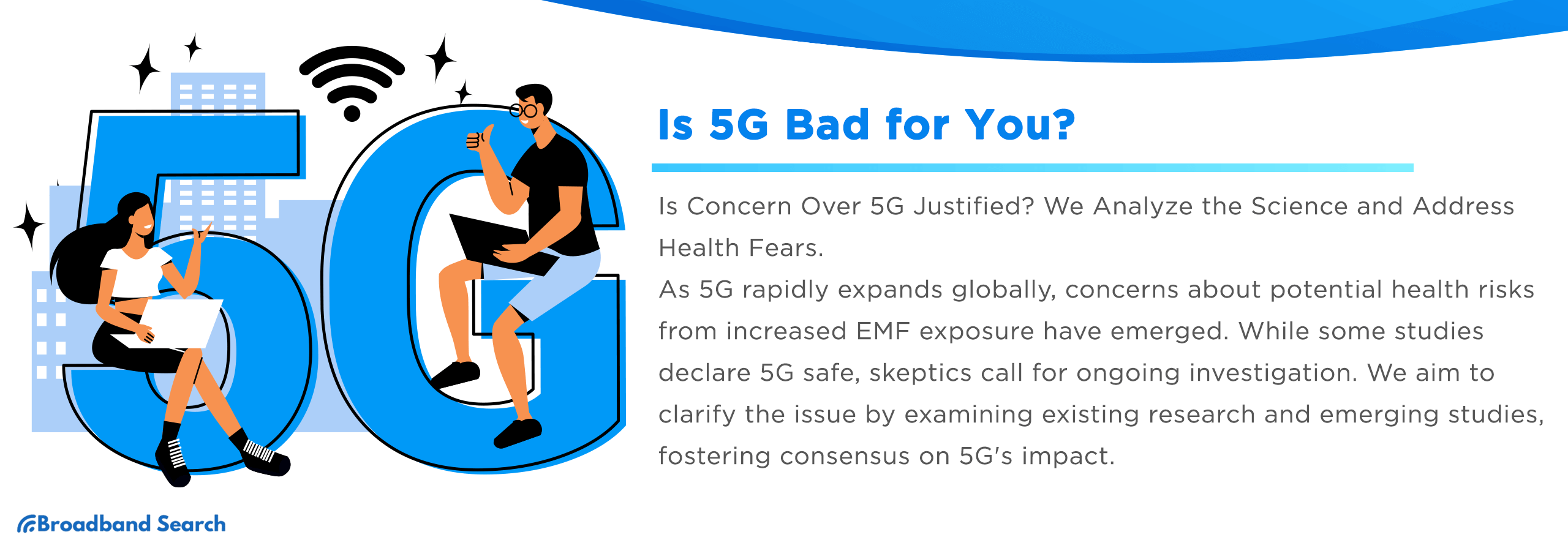As 5G technology unfurls its rapid connectivity across the globe, public apprehension concurrently ascends, intertwining with expectations of unprecedented speed and reliability. Notable concerns primarily orbit around potential health risks due to increased electromagnetic field (EMF) exposure. A study by the International Commission on Non-Ionizing Radiation Protection, declares 5G safe, though skeptics demand continuous vigilance and further investigation.
In this perplexing panorama, deciphering whether 5G is pernicious or benign demands a meticulous scrutiny of existing scientific literature, alongside an analytical perspective on emergent studies. Observers anticipate that addressing prevailing concerns will illuminate the discourse, steering it towards a consensus that underpins both public health and technological advancement.
Overview of the 5G Technology
The inception of 5G introduces a revolutionized spectrum of frequency bands, notably featuring both sub-6 GHz and millimeter waves (24-100 GHz). The sub-6GHz spectrum ensures widespread coverage, while the elevated frequency millimeter waves promise unprecedented data speeds and capacity, albeit with limited range, paving the way for a seamless, hyper-connected digital experience unprecedented in the annals of telecommunications.
Network Infrastructure of 5G comprises:
- Small Cells: Vital for increasing coverage and capacity, small cells are mini base stations pivotal for the millimeter-wave spectrum.
- Massive MIMO: With more antennas per base station, it supports multiple input, multiple output technology for improved capacity.
- Edge Computing: Facilitating reduced latency, Edge computing fosters data processing closer to the data source, enhancing the network’s responsiveness.
This infrastructure amalgamation orchestrates a symphony of efficiency and speed, offering a transformative blueprint for future wireless technology.
Applications of 5G
The advent of 5G technology is poised to revolutionize not only telecommunications but myriad domains across the digital landscape. This unprecedented leap in connectivity brings transformative capabilities that transcend traditional mobile communication paradigms.
- Telecommunications: 5G promises faster data speeds and reduced latency, unlocking high-resolution video streaming and augmented reality experiences previously unattainable on older networks.
- Internet of Things (IoT): 5G acts as the backbone for IoT's expansion, ensuring seamless and instantaneous communication between billions of interconnected devices, elevating industries and consumer experiences.
- Smart Cities and Autonomous Vehicles: With its ultra-reliable low latency communication (URLLC), 5G plays a pivotal role in orchestrating smart city infrastructures and ensuring the safe and efficient operation of autonomous vehicles within urban ecosystems.
Each application signifies a stride towards a more interconnected and efficient digital future, underpinned by 5G's unparalleled technical prowess.
Benefits of 5G Technology
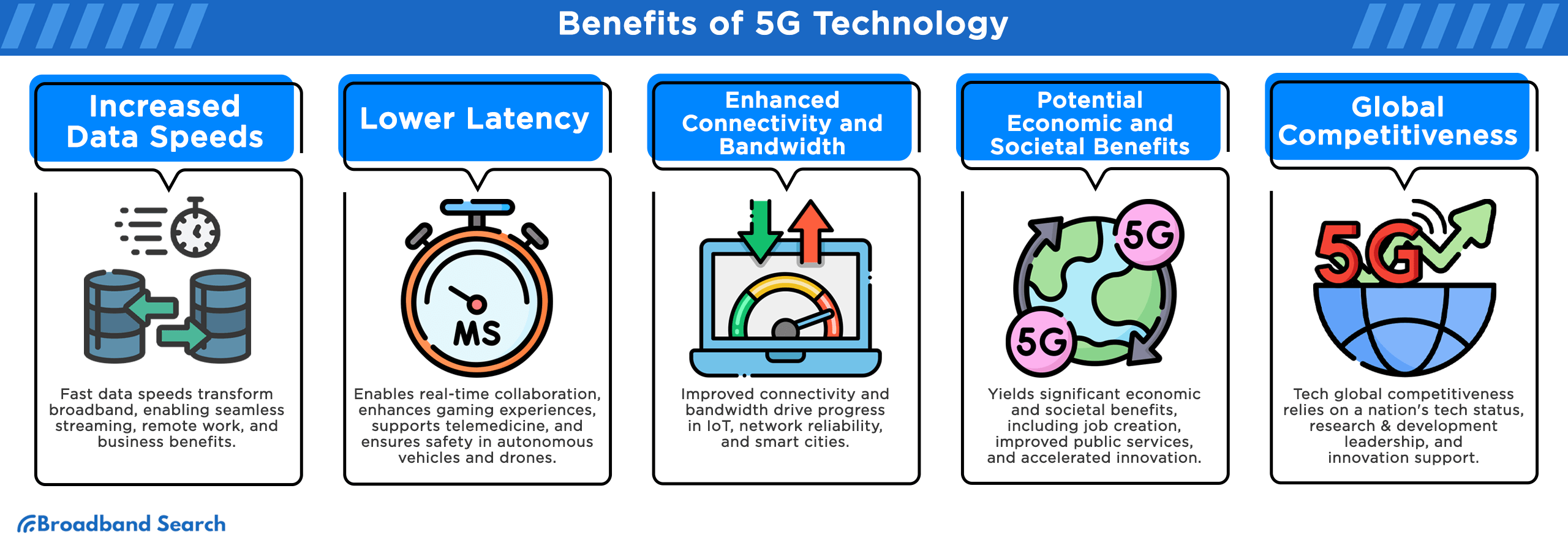
Increased Data Speeds
The surge in data speeds due to advanced networking technologies significantly elevates broadband services. Users experience minimal latency and rapid content delivery, fostering an environment where high-definition streaming and large file transfers occur seamlessly and efficiently, essential for both entertainment and critical data applications.
- Enhancement in Broadband Services: Enhancements in broadband services have ushered in a new era of connectivity, providing unprecedented speeds and reliability. Recent upgrades, reflected in increased fiber-optic deployments and the adoption of 5G technology, ensure a robust, future-proof digital infrastructure. According to Ookla's Speedtest Global Index, global broadband speeds have consistently improved, with significant jumps noted year over year, evidencing a steadfast commitment to connecting the globe efficiently.
- Transforming remote work and education: Accelerated data speeds in 2023 have revolutionized remote work and education, dismantling previous limitations. Enhanced connectivity, evidenced by global average network speeds witnessing a substantial uplift, facilitates seamless video conferencing and instantaneous data access, fostering productivity and engagement in virtual environments. These advancements in network infrastructure continue to bridge the digital divide, making remote collaboration more accessible and effective for individuals worldwide.
- Benefits to businesses and remote work environments:
- Enhanced Streaming: Improved bandwidth supports high-quality, uninterrupted streaming, vital for virtual meetings and presentations.
- Efficient Gaming Industry: Fast, reliable connections facilitate smoother gaming experiences, driving engagement and revenue in the online gaming sector.
- Remote Collaboration: With advanced cloud services and collaborative tools, teams can work synchronously, enhancing productivity and work flexibility.
Through these advancements, increased data speeds are not merely improving existing services but also acting as catalysts for innovation and new opportunities across various sectors.
Lower Latency
In the digital communication sphere, lower latency is tantamount to instantaneous response times, fundamentally altering various technology applications.
- Real-time Communication and Collaboration: Reduced latency fosters real-time communication and collaboration, critical for professionals working across disparate locations, ensuring synchronization and immediate data sharing, enhancing productivity and decision-making processes in the corporate landscape.
- Gaming & Virtual Reality: Improvements in latency have elevated gaming and virtual reality experiences to unprecedented levels, offering users seamless, immersive environments free from disruptive lags or delays, crucial for the optimal enjoyment and engagement within these digital realms.
- Telemedicine & Remote Surgeries: Advanced low-latency networks empower telemedicine services and facilitate remote surgeries, enabling healthcare professionals to deliver timely, efficient, and life-saving medical interventions regardless of geographical constraints, expanding the reach and efficacy of global healthcare provision.
- Autonomous Vehicles & Drones: For autonomous vehicles and drones, low latency is indispensable. It guarantees immediate response to commands and accurate navigation, essential for safety and operational efficiency in dynamic environments, supporting the burgeoning field of automated transportation and delivery services in 2023.
Enhanced Connectivity and Bandwidth
Enhanced connectivity and increased bandwidth have become quintessential pillars for fostering a digitally inclusive future, driving significant advancements across various domains.
- Connect More Devices: The surge in bandwidth accommodates more devices simultaneously, supporting the growing IoT environment. With billions of devices online, enhanced connectivity ensures seamless operation and data exchange, pivotal for both commercial and personal applications.
- Network Reliability and Coverage: 2023 witnessed considerable improvements in network reliability and coverage, directly attributed to enhanced connectivity and expanded bandwidth. These advancements are instrumental in delivering consistent, uninterrupted services to users, thereby fostering an environment where digital accessibility is not just a privilege but a universal standard.
- Smart Homes and Cities: Enhanced connectivity is the linchpin for evolving smart home ecosystems and burgeoning smart cities. With a reliable and high bandwidth network, devices and systems within these connected environments can interact efficiently, providing residents with sophisticated, automated, and integrated solutions that markedly improve the quality of life and streamline urban management and services.
Potential Economic and Societal Benefits
The intertwining of technology and societal fabric paves the way for profound economic and societal upliftments, catalyzing myriad advantages.
- Job Creation & Economic Growth: 2023 studies underscore that technological advancements directly correlate with a surge in job opportunities and robust economic growth. As industries evolve, new roles emerge, fostering employment and spurring economies forward, fueling a cycle of prosperity.
- Public Services & Infrastructure: Enhanced technology bolsters public services and infrastructure. Modernized systems, empowered by data-driven insights, optimize public transportation, utilities, and emergency services, facilitating more responsive and efficient systems that tangibly uplift the quality of community life.
- Technological Innovation & Development: The continual technological evolution accelerates the pace of innovation, driving sectors like AI, biotechnology, and renewable energy to new frontiers. This momentum, underpinned by collaborative global endeavors, not only promises a technologically advanced future but also addresses pivotal societal challenges with newfound vigor.
Global Competitiveness
The importance of global competitiveness in the technological arena cannot be overstated, as nations strive to secure a vantage point in an increasingly digitized world landscape.
- Enhancing Technological Standing: A nation's global competitiveness increasingly hinges on its technological standing. Investments in digital infrastructure and education enable countries to partake actively in the global digital economy, ensuring they are not left behind in the race towards a more digitized, connected future.
- Aiding R&D Ventures: Countries leading in research and development (R&D) are invariably at the forefront of global competitiveness. In 2023, significant funding and policy support for R&D activities have accelerated breakthroughs in various fields, reinforcing a country's position as a hub of innovation and attracting talent and investments from around the globe.
- Foundation for Innovation: Establishing a foundation for future innovation is imperative for sustained competitiveness. By fostering an environment that encourages entrepreneurial spirit, supports startups, and facilitates the implementation of cutting-edge technologies, nations can ensure they are well-positioned to lead in the unfolding technological renaissance.
Debunking Common Myths About 5G Technology
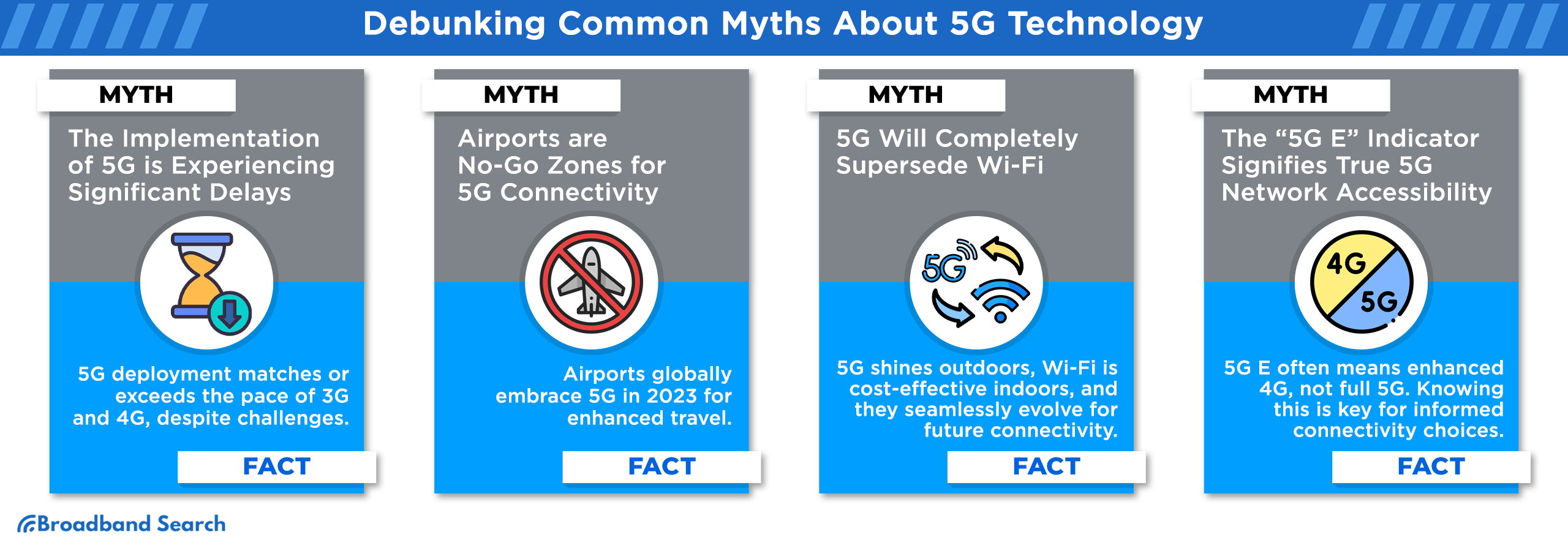
Myth 1: The Implementation of 5G is Experiencing Significant Delays
Contrary to the prevailing myth, 5G deployment is progressing steadily. While certain regions face regulatory and logistical challenges, its rollout remains comparable to prior network generations, debunking notions of significant delays.
- Current Pace of Deployment: As of 2022, the global rollout of 5G networks is progressing at a steady, substantial rate, with numerous nations successfully initiating and expanding their 5G infrastructures, demonstrating a robust commitment to this transformative technology.
- Perceived Delays: Several factors contribute to the notion of delays in 5G implementation. Regulatory hurdles, logistical challenges, and initial public skepticism have played roles in slowing down the process in some regions. However, these are typical challenges encountered during the deployment of new, groundbreaking technologies.
- Comparison with Previous Networks: When juxtaposed with the deployment of predecessor networks like 3G and 4G, 5G’s rollout is in a comparable or even accelerated time frame. Every generation of network technology has faced its set of challenges and delays, with 5G being no exception, but the current deployment is unfolding within expected parameters.
Myth 2: Airports are No-Go Zones for 5G Connectivity
With advanced planning and technological adjustments, many airports globally are integrating 5G, ensuring travelers enjoy enhanced connectivity without compromising safety or interfering with sensitive equipment.
- Global 5G Deployment: As of 2023, the trajectory of 5G incorporation within airports worldwide is steadily ascending, with numerous hubs successfully adopting and leveraging the superior connectivity offered by this next-generation technology, enhancing operational efficiency and traveler experience.
- Factors for Perceived Delays: The conception of delays in airport 5G implementation can be traced to concerns regarding potential interference with aircraft equipment and operational systems. However, with careful planning and strategic technological deployment, these challenges have been systematically addressed and mitigated.
- Comparison with Past Networks: Reflecting on the incorporation of earlier networks, the 5G implementation timeline within airports is not anomalously delayed. Each transition to a newer network within such sensitive environments has historically required meticulous planning and stringent testing to ensure safety and reliability, with 5G following a similar, expected pattern.
Myth 3: 5G Will Completely Supersede Wi-Fi
While 5G provides fast, reliable connectivity outdoors, Wi-Fi remains optimal for indoor networks due to its cost-effectiveness, ease of setup, and the prevalent infrastructure already established globally.
- Synergistic Relationship: 5G and Wi-Fi networks seamlessly coexist and collaborate to offer users continuous connectivity. The synergy between these technologies ensures efficient data transfer, facilitating a smoother, more reliable online experience in various environments.
- Applications and Strengths: 5G excels in providing high-speed connectivity across vast distances outdoors, while Wi-Fi is unparalleled for indoor network setups due to its cost efficiency and simplicity. Recognizing their distinct applications and strengths is essential for leveraging each technology's unique benefits effectively.
- Co-Evolution Prospects: Looking forward, 5G and Wi-Fi will likely co-evolve, with each technology undergoing innovations to address emerging user needs and connectivity challenges. The continuous development and integration of these networks will underpin the future landscape of digital communication, supporting the next generation of devices and applications.
Myth 4: The “5G E” Indicator Signifies True 5G Network Accessibility
The "5G E" indicator can mislead users into thinking they're on a genuine 5G network. In reality, it often denotes an enhanced 4G LTE network, not the full 5G experience, potentially leading to misconceptions about network capabilities.
- Deciphering Network Indicators: "5G E" stands for "5G Evolution," a term introduced by some carriers to denote advanced 4G LTE networks. It can mislead consumers into believing they're on full-fledged 5G networks, highlighting the importance of understanding these network symbols on our devices.
- Technical Differences: True 5G networks and "5G E" are not the same. The latter is an enhanced 4G LTE network with faster speeds and reduced latency, but it lacks the advanced capabilities and performance characteristics of genuine 5G, such as ultra-low latency and massive device connectivity.
- Consumer Awareness: To navigate the evolving landscape of mobile networks effectively, consumers must stay informed about the meaning of these network symbols. Recognizing the difference between "5G E" and true 5G ensures that users have accurate expectations regarding network capabilities, thereby making informed choices about their connectivity options.
Health Concerns Surrounding 5G Technology
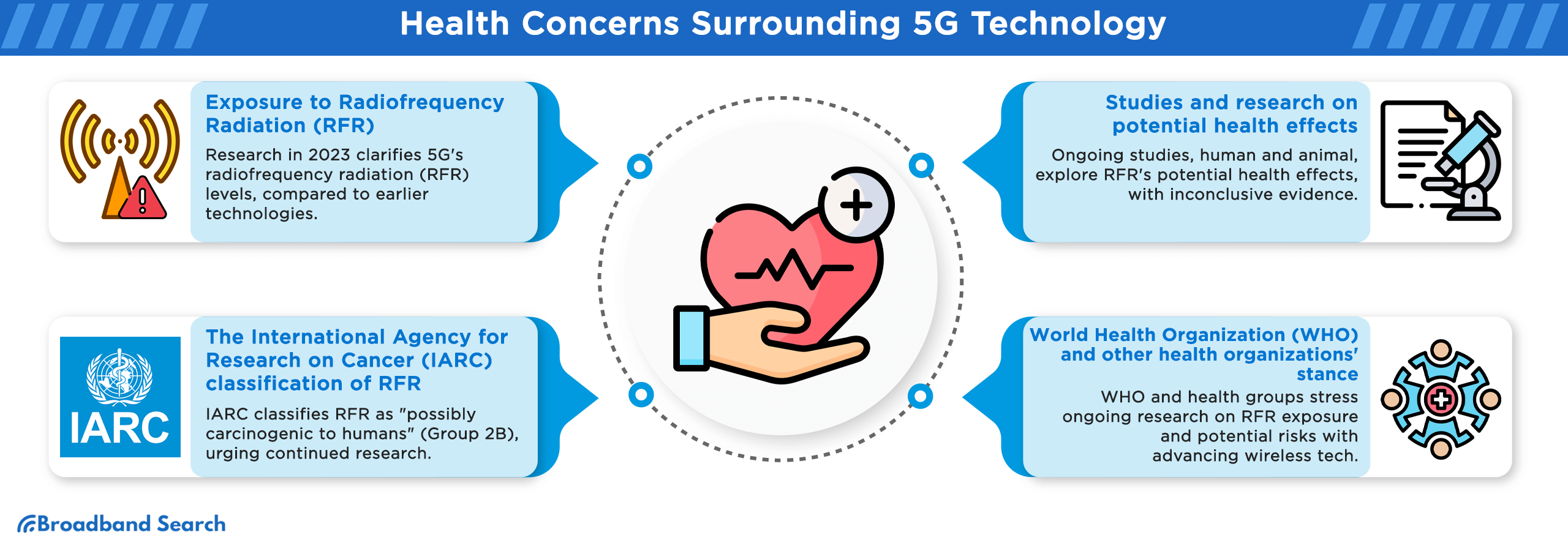
Exposure to Radiofrequency Radiation (RFR)
Understanding radiofrequency radiation (RFR) exposure, especially in the context of 5G, is a topic of paramount importance. It requires an exploration of the current comprehension of RFR exposure levels associated with 5G and a comparative analysis with its predecessors, such as 4G and 3G networks, to ascertain potential differences and implications for public health and safety.
- Current Understanding of RFR Exposure in 5G: In 2023, extensive research and studies have provided us with a comprehensive perspective on the levels of radiofrequency radiation exposure associated with 5G technology. These findings help elucidate the potential impact on human health and the environment, shedding light on the safety of 5G networks.
- Comparison with Previous Generation Technologies: To assess the implications of 5G RFR exposure, it is imperative to draw comparisons with the radiofrequency radiation emitted by earlier generations of wireless technology, such as 4G and 3G. This comparative analysis enables us to discern whether 5G introduces significant variations in RFR exposure levels and, subsequently, any potential health or safety considerations that may arise from these differences.
The International Agency for Research on Cancer (IARC) classification of RFR
In 2023, the International Agency for Research on Cancer (IARC) classification of radiofrequency radiation (RFR) remains a pivotal reference point in understanding potential health risks. IARC has classified RFR as "possibly carcinogenic to humans" (Group 2B), based on limited evidence linking it to certain cancers. While this classification warrants continued research and scrutiny, it underscores the importance of ongoing investigations into the impact of RFR exposure, especially in the context of evolving wireless technologies like 5G.
Studies and research on potential health effects
In the ever-evolving landscape of technology, comprehensive studies and research endeavors persistently examine the potential health effects associated with exposure to radiofrequency radiation (RFR). These investigations encompass both human and animal studies, each offering distinct insights into the impact of RFR on biological systems.
- Human Studies: As of 2023, numerous human studies have explored the connection between RFR exposure and various health outcomes. While some studies suggest potential links to adverse health effects, such as electromagnetic hypersensitivity or certain cancers, the overall body of evidence remains inconclusive, necessitating continued research to establish concrete conclusions.
- Animal Studies: Complementary to human studies, research on animals provides valuable data for understanding the biological mechanisms underlying RFR exposure. These studies have yielded insights into potential physiological changes in response to RFR, aiding in risk assessment. However, translating findings from animal models to human health effects requires cautious interpretation, as interspecies differences exist.
This ongoing scientific exploration underscores the need for diligent, evidence-based investigations to determine the full spectrum of potential health effects associated with RFR exposure, particularly in the context of rapidly advancing technologies like 5G.
World Health Organization (WHO) and other health organizations' stance
The stance of prominent health organizations, including the World Health Organization (WHO), remains crucial in shaping our understanding of radiofrequency radiation (RFR) exposure. WHO categorizes RFR as "possibly carcinogenic to humans" (Group 2B), stressing the need for continued research. Other health bodies align with WHO's precautionary approach, advocating ongoing investigations to elucidate potential health risks. Their positions underscore the significance of monitoring and research in the context of evolving wireless technologies.
Environmental Concerns
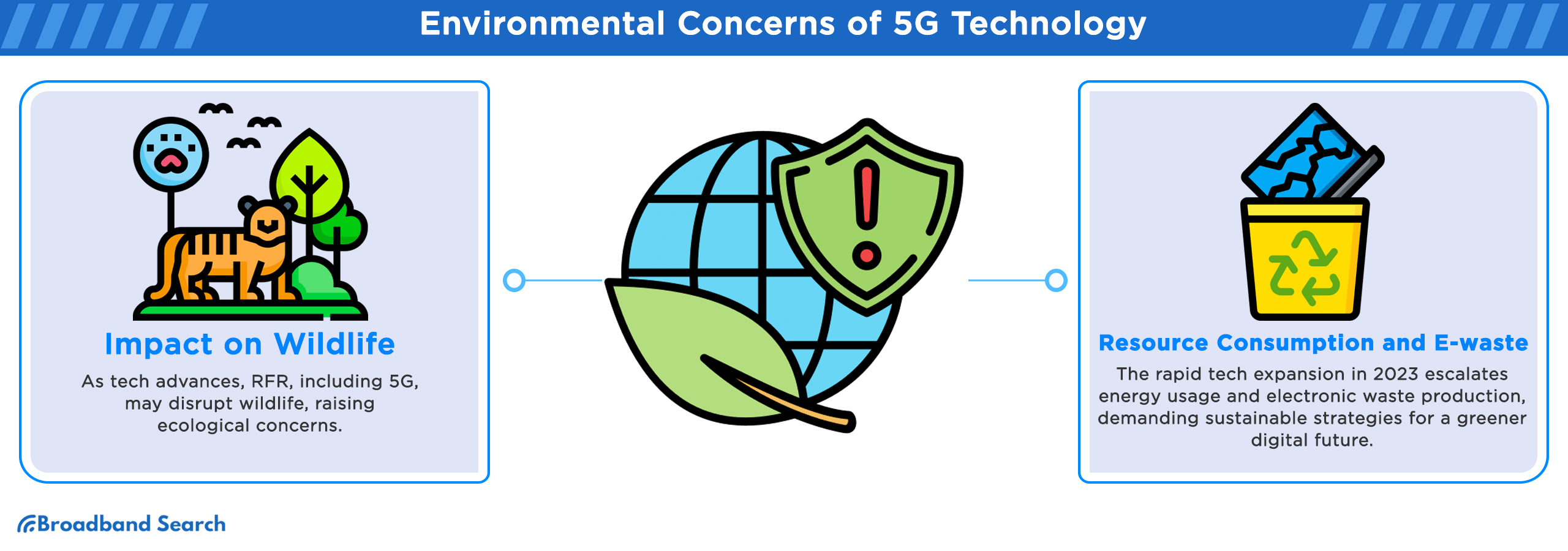
Impact on wildlife
As technology continues to advance, it's imperative to consider its potential impact on wildlife. Recent studies have raised concerns about the effects of wireless technology, including 5G, on various facets of the natural world.
- Bird Migration: Recent studies suggest that RFR exposure might interfere with bird migration patterns, potentially disrupting their navigational abilities. This has raised questions about the long-term consequences for avian populations and ecosystems reliant on their seasonal movements.
- Effects on Insects and Plants: Similarly, there's growing attention to the effects of RFR on insects and plant life. Emerging research highlights the potential implications on insect navigation and plant pollination, with concerns over ecological imbalances and biodiversity impacts. As wireless technologies continue to evolve, understanding these nuances becomes imperative for responsible and sustainable tech integration within our ecosystems.
Resource consumption and e-waste
The exponential growth of technology has triggered concerns over its profound impact on resource consumption and electronic waste generation.
- Energy Consumption: Recent studies in 2023 indicate that the energy demands of digital technologies, including data centers and network infrastructure, are escalating dramatically. This surge raises ecological questions, highlighting the need for more sustainable approaches to mitigate the environmental footprint.
- Electronic Waste and Recycling Challenges: The proliferation of electronic devices contributes significantly to electronic waste (e-waste). Current statistics reveal mounting challenges in managing and recycling e-waste effectively, emphasizing the urgency of developing robust, circular economy solutions to address the e-waste crisis. As technology continues to evolve, addressing these resource and waste management issues becomes imperative for a sustainable digital future.
Counterarguments and Mitigating Factors
Safety measures and guidelines set by regulatory bodies
Ensuring the safety of wireless technology consumers is paramount, and regulatory bodies like the Federal Communications Commission (FCC) in the US play a pivotal role in establishing and enforcing guidelines to safeguard public health.
- FCC Regulations: In 2023, the FCC continues to set stringent regulations regarding radiofrequency radiation (RFR) exposure limits, rooted in scientific assessments. These guidelines, periodically reviewed and updated, ensure that wireless technologies, including 5G, adhere to established safety thresholds.
- Equipment Certification: The FCC mandates rigorous testing and certification processes for wireless devices, ensuring that they meet safety standards before they reach the market. This rigorous scrutiny promotes the safe deployment of wireless technologies across the nation.
- Public Awareness: Alongside regulations, the FCC is actively involved in disseminating information to the public. Their initiatives aim to educate consumers about the potential risks associated with RFR exposure, empowering individuals to make informed decisions regarding their device usage.
These measures collectively demonstrate the FCC's commitment to balancing technological advancement with the paramount importance of safeguarding public health and safety.
Technological advancements addressing safety concerns
As technology continually evolves, it brings with it the imperative to address safety concerns through innovative means and collaborative efforts.
- Research on Safer Technologies: The relentless pursuit of safer technologies is evident in ongoing research initiatives. In 2023, studies focus on developing wireless technologies that minimize potential health risks, exploring novel approaches to reduce electromagnetic emissions and exposure while maintaining optimal performance.
- Community and Industry Initiatives: Both communities and industries are proactively engaged in initiatives promoting safer technology use. Partnerships between stakeholders and organizations strive to raise awareness, implement best practices, and drive the development of responsible technology solutions. These collective efforts underscore a commitment to harnessing the power of technology while safeguarding public health and well-being.
5G Technology and Society
Integration of 5G with existing infrastructures
The integration of 5G into existing infrastructures has emerged as a transformative endeavor, promising to enhance connectivity in both urban and rural settings.
- Upgrading Urban and Rural Connectivity: The infusion of 5G technology promises to bridge the digital divide between urban and rural areas. For instance, in urban centers, the implementation of 5G small cells within existing infrastructure enables faster data speeds and improved network capacity, facilitating smart city initiatives. In rural regions, the deployment of 5G infrastructure can extend broadband coverage, unlocking new opportunities in healthcare, education, and agriculture.
- Challenges and Solutions: Integrating 5G with legacy networks presents unique challenges. For example, harmonizing 5G's higher-frequency bands with existing cellular infrastructure requires careful planning to prevent interference. Solutions include spectrum management and coordinated deployment to ensure seamless coexistence between technologies. As 5G continues to roll out, innovative strategies will be essential in mitigating integration challenges and optimizing network performance.
Privacy and Security Concerns
In an era where data is the new currency, addressing privacy and security concerns is paramount to harnessing the full potential of 5G technology while ensuring the safety and privacy of users and their data.
- Data Privacy Implications: The integration of 5G technology amplifies data privacy concerns. For instance, the exponential growth in IoT devices increases the volume of personal data collected. Recent high-profile data breaches underscore the critical need to safeguard user information and maintain trust.
- Potential Increase in Cybersecurity Threats: The advent of 5G networks expands the attack surface, potentially leading to a surge in cybersecurity threats. As networks become more complex, malicious actors exploit vulnerabilities. This necessitates heightened cybersecurity measures to protect against threats like DDoS attacks and data theft.
- Measures to Protect User Data and Privacy: To mitigate these concerns, stringent measures are being implemented. For example, end-to-end encryption in 5G communications enhances data security. Additionally, robust authentication mechanisms and intrusion detection systems fortify network defenses, exemplifying the industry's commitment to ensuring user data privacy and cybersecurity in this transformative era.
Digital Divide
The digital divide, a persistent global challenge, hinges on the transformative potential of 5G technology and concerted efforts by governments and industries.
- The Role of 5G: 5G's deployment carries the potential to either bridge or exacerbate the digital divide. In urban areas, high-speed 5G networks can empower communities with faster internet access, fostering economic growth. Conversely, rural or underserved regions may lag behind without equal access to 5G, deepening the divide.
- Government and Industry Efforts: Governments and industries are intensifying efforts to bridge this gap. For example, in remote areas, government-funded initiatives are subsidizing 5G infrastructure deployments to ensure broader access. Telecom companies are working on affordable 5G plans to make high-speed internet more accessible to underserved populations.
The ability of 5G to narrow the digital divide depends on equitable access, innovative policies, and collaborative initiatives between public and private sectors. Bridging this gap is not just a technological challenge but also a societal imperative.
The Takeaway
Our exploration of 5G technology has shed light on its multifaceted impact. We delved into its role in transforming connectivity, fostering economic growth, and enhancing various sectors, while also addressing critical concerns related to safety, security, and environmental sustainability.
As of 2023, the consensus regarding potential health risks remains nuanced. While regulatory bodies assert that 5G, when within recommended limits, is safe, ongoing research continues to scrutinize its long-term effects. This highlights the importance of continuous monitoring, robust safety standards, and public awareness.
To navigate the evolving landscape of 5G technology effectively, further research and studies are essential. These should focus on refining safety guidelines, addressing cybersecurity challenges, and harnessing the full potential of 5G while ensuring responsible deployment. As society adapts to the digital era, a holistic approach, driven by collaboration between governments, industries, and the scientific community, is crucial to harnessing the transformative power of 5G for the benefit of all.
FAQ
Are there any conclusive studies linking 5G to adverse health effects?
As of now, there are no conclusive studies definitively linking 5G technology to adverse health effects. While ongoing research explores potential risks, the current consensus underscores the need for further investigation.
How does 5G radiation compare to previous generations of wireless technology in terms of safety?
5G radiation is comparable to previous generations of wireless technology in terms of safety. Regulatory bodies established safety standards, and current evidence suggests that 5G operates within these limits, similar to 3G and 4G technologies.
Are there any specific safety recommendations for limiting 5G exposure?
Yes, specific safety recommendations exist to limit 5G exposure. These include maintaining a safe distance from antennas, reducing device usage when signal strength is low, and using hands-free options for prolonged calls.
How does 5G compare to previous network generations (3G, 4G) in terms of health risks?
5G, 3G, and 4G technologies all use radiofrequency radiation (RFR). Current research suggests that the RFR exposure from 5G is similar to its predecessors, with no conclusive evidence of significantly higher health risks associated with 5G compared to 3G or 4G.
How can I stay informed about the latest developments in 5G safety research?
To stay informed about the latest developments in 5G safety research, consider following reputable sources such as government health agencies, scientific journals, and technology news outlets. Additionally, attending conferences and seminars focused on wireless technology and health can provide valuable insights and updates.

